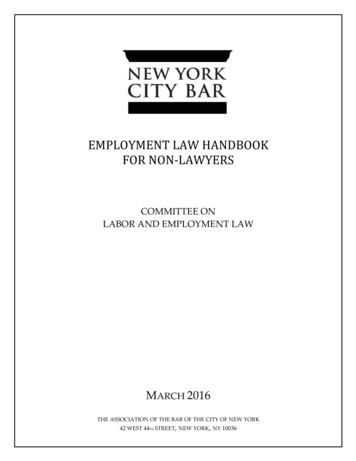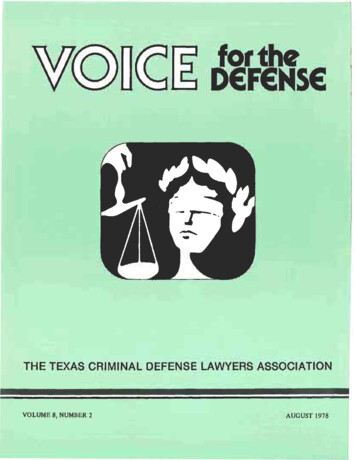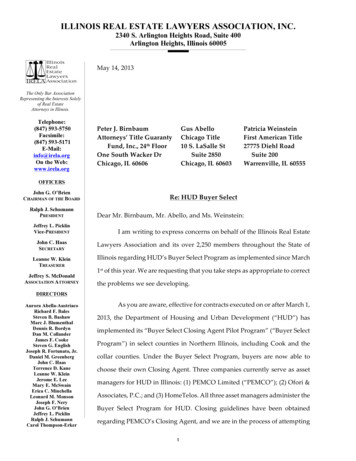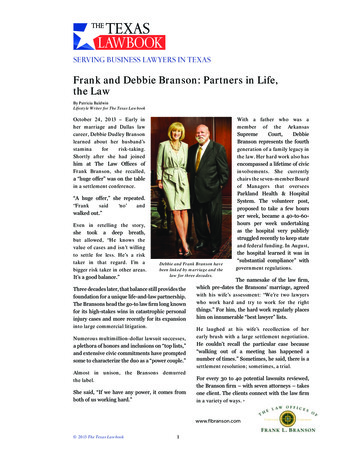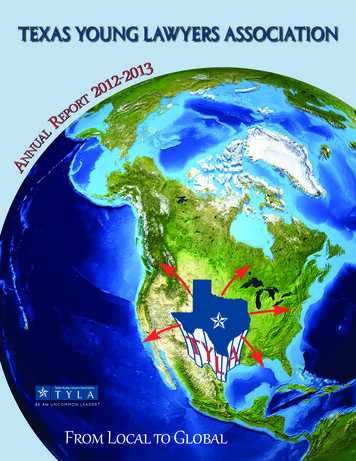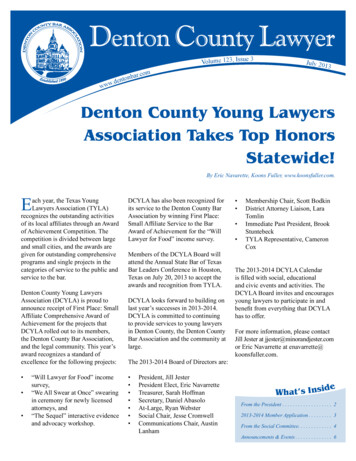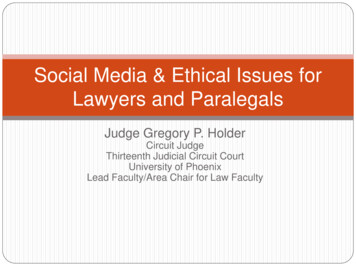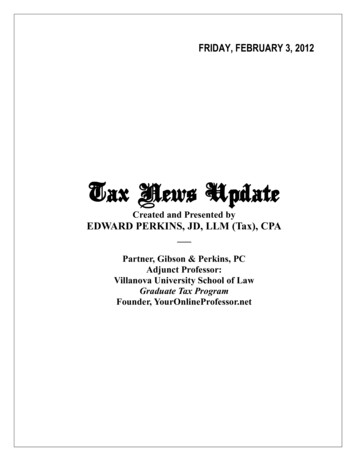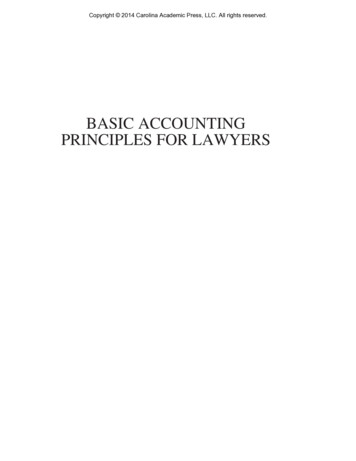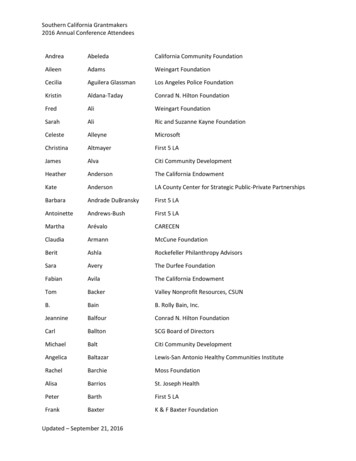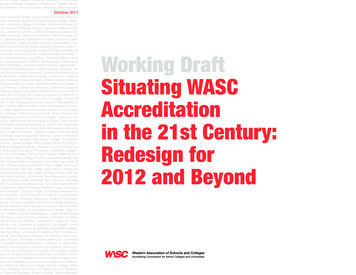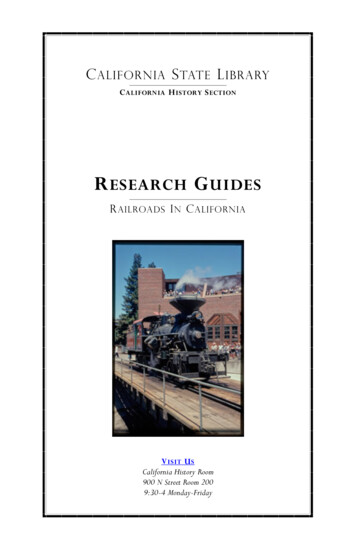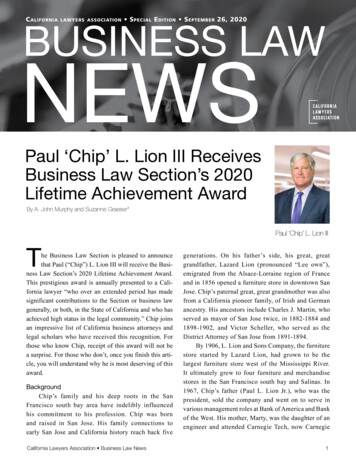
Transcription
BUSINESS LAWC alifornialawyers association S pecial E dition S eptember 26, 2020NEWSPaul ‘Chip’ L. Lion III ReceivesBusiness Law Section’s 2020Lifetime Achievement AwardBy A. John Murphy and Suzanne Graeser*Paul ‘Chip’ L. Lion IIIThe Business Law Section is pleased to announcethat Paul (“Chip”) L. Lion III will receive the Business Law Section’s 2020 Lifetime Achievement Award.This prestigious award is annually presented to a California lawyer “who over an extended period has madesignificant contributions to the Section or business lawgenerally, or both, in the State of California and who hasachieved high status in the legal community.” Chip joinsan impressive list of California business attorneys andlegal scholars who have received this recognition. Forthose who know Chip, receipt of this award will not bea surprise. For those who don’t, once you finish this article, you will understand why he is most deserving of thisaward.BackgroundChip’s family and his deep roots in the SanFrancisco south bay area have indelibly influencedhis commitment to his profession. Chip was bornand raised in San Jose. His family connections toearly San Jose and California history reach back fiveCalifornia Lawyers Association Business Law Newsgenerations. On his father’s side, his great, greatgrandfather, Lazard Lion (pronounced “Lee own”),emigrated from the Alsace-Lorraine region of Franceand in 1856 opened a furniture store in downtown SanJose. Chip’s paternal great, great grandmother was alsofrom a California pioneer family, of Irish and Germanancestry. His ancestors include Charles J. Martin, whoserved as mayor of San Jose twice, in 1882-1884 and1898-1902, and Victor Scheller, who served as theDistrict Attorney of San Jose from 1891-1894.By 1906, L. Lion and Sons Company, the furniturestore started by Lazard Lion, had grown to be thelargest furniture store west of the Mississippi River.It ultimately grew to four furniture and merchandisestores in the San Francisco south bay and Salinas. In1967, Chip’s father (Paul L. Lion Jr.), who was thepresident, sold the company and went on to serve invarious management roles at Bank of America and Bankof the West. His mother, Marty, was the daughter of anengineer and attended Carnegie Tech, now Carnegie1
Mellon University. Together they raised four children,Chip, Steve, Alexandra, and Christopher, in San Jose.Both of Chip’s parents were actively involved inleadership roles in local non-profit organizations andinstilled in their children a sense of duty to give back totheir communities and professions. His parents’ senseof duty to the community strongly influenced Chip andunderlies his effort to instill a similar commitment inthe next generation of attorneys.Chip was a fraternal twin, born eight minutesbefore his brother Steve. Sadly, Steve died two yearsago from pancreatic cancer. Steve and Chip were veryclose. They worked summer jobs together, shared thesame friends, and even belonged to the same nationalfraternity, although at different schools. By Chip’sown admission, Steve was bigger, stronger, and moreoutgoing, while Chip was more reserved and bookish.Chip credits Steve for helping him develop his socialskills by allowing Chip to ride his social coattails asthey grew up. Anyone who knows Chip today wouldhave great difficulty envisioning Chip being shy orreserved.After high school, Chip attended the Universityof California at Davis, where in 1979 he received aB.A. degree with honors in Political Science and waselected to Phi Beta Kappa. While at Davis, he playedvarsity soccer for three years, as well as lacrosse atthe club level. Chip attended law school at Santa ClaraUniversity, where he graduated magna cum laude in1982. In addition, Chip served as the Associate Editorof the Santa Clara Law Review and was the ViceChairman of the Honors Moot Court Board. In 2015,Chip received the Alumni Special Achievement Awardfrom the law school.Chip attended law school with the goal of becominga transactional attorney, focusing in business law.Because most business transactions have underlyingtax considerations, Chip took several tax courseswhile in law school and discovered that he enjoyed theintellectual challenge of tax law. To further develop histax skills, Chip attended New York University, wherehe received his LL.M in taxation in 1983.While in his second year of law school, Chip methis wife, Mary Cunneen, who was in her senior year atSanta Clara. Although Chip’s and Mary’s parents knew2each other, Chip had never met Mary. His introductioncame about when Mary’s father, who had playedlacrosse at the U.S. Naval Academy, invited Chip tocome to his house for an organizational meeting to helpcreate a lacrosse club team at Santa Clara University.There, Chip met Mary. They started dating, and weremarried in 1983.After graduating from Santa Clara, Mary went towork at the headquarters of Hewlett-Packard in PaloAlto. While at HP, Mary started in the MBA eveningprogram at Santa Clara, but then left HP to have theirfirst child, Paul L. Lion IV, known as “CJ.” Two yearslater, a daughter, Moira, was born. Mary received herMBA while pregnant with her third child, Ryan. Whilebusy raising three children, Mary found time to beactively involved in political campaigns, including thecampaigns of her brother, Jim Cunneen, who served inthe California State Assembly for six years.Chip’s greatest joy has been to see his childrengrow to become responsible, intellectually curious,and compassionate young adults. CJ received his B.A.and Medical Degrees from Georgetown University. Hewas recently picked by the faculty and his peers to bethe Chief Resident of Anesthesiology at Georgetown.Moira received her B.A. from the University ofSouthern California. She then attended Loyola LawSchool, where she served as the Chief Justice ofthe Moot Court Board, graduating with IntellectualProperty Law Concentration honors. Moira is nowpracticing trademark law at a prominent Silicon Valleylaw firm. Ryan received his B.A. from Notre DameUniversity, a Master of Science Degree in PublicHealth from Duke University, and his Medical Degreefrom Georgetown. He has gone to Africa to conducthealth and medical research on five separate occasionsand is currently serving his pediatrics residency atLucile Packard Children’s Hospital Stanford.Legal PracticeAfter receiving his LL.M in tax from NYU,Chip joined Hopkins & Carley, a well-regarded midsize San Jose law firm. At first, he primarily workedfor John Hopkins, a prominent tax attorney and firmfounder. Over the next decade, he increasingly didgeneral corporate and transactional work, often withcorporate partner, Michael Phillips, who focused onBusiness Law News California Lawyers Association
emerging company/venture capital work. Chip madepartner after four years and served as one of the lawfirm’s managing partners.During Chip’s time at H&C, the high-techindustry underwent explosive growth in Silicon Valley.At the same time many of the major San Francisco lawfirms, as well as a number of national law firms, beganto open offices in Silicon Valley--particularly northof San Jose, in and around the City of Palo Alto--toprovide legal services to the high tech industry. Severalhome-based Palo Alto firms were also experiencingsubstantial growth, providing a broad range of legalservices to the technology community.Chip enjoyed working at H&C, and particularlyappreciated the mentoring he received from JohnHopkins. He also had a strong attachment to San Jose,where his family had roots in the business communitygoing back to the 1850s. Nevertheless, Chip felt that agreater opportunity to fully develop his legal skills andgrow his practice lay with a law firm more concentratedin high tech work and having an international reach.After much reflection, Chip made one of the mostdifficult decisions he had ever made and accepted apartnership offer from Morrison & Foerster LLP tojoin its corporate practice group in Palo Alto. Chipwas attracted to M&F by not only its outstandinglegal reputation, client base, and capabilities, butalso its reputation for pro bono work, involvementin community affairs, collaborative culture, andcommitment to the profession. Since joining M&F in1995, Chip has served in a number of managementroles, including Co-Chair of the firm-wide PrivateFunds Group and Chair of the Corporate FinanceGroup in Palo Alto, as well as a member of the firmwide Compensation Committee and chair of the firmwide Chair Selection Committee. Chip also has been anactive mentor and teacher to junior attorneys at M&F,where many lawyers attribute their professional growthand career success to Chip’s efforts and guidance.Although he began his career with a focus on taxmatters, Chip’s legal practice steadily moved towardtransactional work. In 25 years of practice at M&F,Chip has represented public and private companieson corporate governance matters and in a broadrange of industries and business sectors, includingCalifornia Lawyers Association Business Law Newsbiotechnology, medical devices, finance, real estate,and information technology. In the course of workingin these areas, Chip frequently deals with issuesinvolving corporate, limited liability company, andlimited partnership law, state and federal securitieslaw (Securities Act of 1933, Securities Exchange Actof 1934, and the Investment Adviser Act of 1940), aswell as federal and state tax issues, money launderingregulations, privacy act issues, and cross bordercompliance.While Chip continues to manage a “traditional”Silicon Valley corporate practice representingemerging growth companies and advising on M&Aliquidity events, today the bulk of Chip’s timeinvolves working with venture capital, private equity,and pooled investment fund sponsors. As co-chair ofM&F’s Private Funds Group, he advises institutionalinvestors and fund sponsors on a range of legal andbusiness issues, including the formation and operationof, and investments involving, venture capital funds,leveraged buyout funds, private equity funds, andreal estate funds. In addition, he advises Fortune500 companies, as well as other businesses, on thestructure and implementation of corporate venturecapital programs and how to monitor and measure theirperformance.During the course of his career, Chip has beeninvolved in several significant developments incorporate and securities law. A noteworthy exampleinvolves his representation of Secondmarket, Inc., anewly organized start-up company that was createdto provide liquidity to shareholders who held sharesin non-public companies. Beginning in 2009, Chipworked with Secondmarket to create a platform forshareholders who owned stock in private companiesto sell their securities in the secondary market. Theprocess of creating this trading platform not onlyproduced a number of federal and state securitieslaw compliance mine fields to be navigated, but alsounique business issues, such as the concern, frequentlyexpressed by companies, that their shares might besold to competitors or buyers not actively involved inthe company. To address this concern, Chip and histeam crafted a range of transfer and buy/sell provisionsto include in corporate charters, while being mindful to3
not cause an unreasonable restraint on the alienation ofsecurities under Delaware corporate law. In recognitionof the significance of this new trading platform, Chipwas asked to present a white paper to the NorthwesternLaw Executive and Professional Education AnnualSecurities Regulation Institute on the legal issuessurrounding secondary markets.Professional ActivitiesChip has had a long and distinguished career inoutside professional activities. During the course of hiscareer, he has served as an adjunct tax law professor,lectured extensively on a wide range of corporateand finance matters, written numerous business lawarticles, served as editor-in-chief of the most prominentbusiness law review in the United States, providedtestimony on proposed legislation, and served onseveral committees drafting and reviewing proposedlegislation. Chip also has held leadership roles in theCalifornia State Bar Business Law Section and theAmerican Bar Association, where he served in a seriesof leadership positions, culminating in his serving aschair of the ABA Business Law Section in 2014-2015.In addition to his active involvement andleadership roles in state and federal bar committees,Chip has authored or co-authored over 35 legalpublications and been a frequent speaker for the ABA,ALI, California State Bar, UC Berkeley, PLI, CEB, andother business law program sponsors. He also has beenactive in internal legal education programs at M&F.Chip’s teaching, writing, and lecturing effortsbegan soon after he graduated from the NYU taxprogram. From 1984-1990, he taught a series of taxcourses as an adjunct law professor at Santa ClaraUniversity School of Law. During this period, Chipbegan to frequently speak and write for the CaliforniaContinuing Education of the Bar on limited partnershipand limited liability company matters. In 1990, Chipwas named the vice-chair of the California State BarBusiness Law Section Partnerships Committee, and theyear after that he was appointed chair of the committee.While serving as the chair of the PartnershipsCommittee in 1991-1992, Chip organized a committeeto draft limited liability company legislation forCalifornia. He appointed Bob Sullivan of Pillsbury,Madison & Sutro to serve as chair of the drafting4committee, who then tapped Don Hess, an associate athis firm, to serve as the reporter. The ultimate result ofthe drafting committee’s effort was the 1994 passageof the California Limited Liability Company Act. Chipstill has one of two original copies of the Act that weresigned by Governor Pete Wilson. Chip also served as anadvisor to the National Conference of Commissionerson Uniform State Laws/Uniform Law Commission,and was a member of drafting committees that draftedthe Revised Uniform Partnership Act, the RevisedUniform Limited Liability Company Act (whichbecame the basis for the California Revised UniformLimited Liability Company Act), and the Model EntityTransactions Act of 2007.Chip’s introduction to the ABA Business LawSection occurred when he was invited to serve asan inaugural member of the editorial board of thesection’s new monthly magazine, Business LawToday. The editorial board had many legal luminaries,including the editor-in-chief, Herb Wander, who wenton to become chair of the section, and Norm Veasey,who was the chief justice of the Delaware SupremeCourt and later served as chair of the section. Althoughhe was the youngest member of editorial board, Chipremembers that his views were sought out and hisinvolvement encouraged. Ultimately, Chip went on toserve a one-year term, from 2011-2012, as the editorin-chief of the Business Law Today.Morrison & Foerster has a long tradition ofencouraging its attorneys to participate and takeleadership roles in professional organizations at boththe state and national level. In 1977, M&F partner CarlLeonard became the first chair of the newly formedCalifornia State Bar Business Law Section (“BLS”).Subsequently, M&F partners Roland Brandel andSuzanne Graeser served as chairs of the California StateBar BLS. Marshall Small, Roland Brandel, and BruceAlan Mann are past recipients of this section’s LifetimeAchievement Award. Former managing partner, BobRaven, served as president of the California StateBar in 1981 and of the ABA in 1988. John Austin andDave Nelson were past chairs of the ABA BusinessLaw Section. Many M&F partners, including MarshallSmall, Bruce Alan Mann, David Lynn, and RolandBusiness Law News California Lawyers Association
Brandel, have also had prominent roles in a number ofthe ABA Business Law Section committees.Although he was an active member of the ABABusiness Law Section LLC and Partnership Committee,Chip’s first involvement in a leadership role in theABA Business Law Section occurred in 2000, whenBruce Alan Mann asked Chip to help him in the newlyformed Venture Capital Committee (now known asthe Private Equity and Venture Capital Committee).After Bruce’s term expired, Chip became the chair ofthe committee, from 2003-2006. After completing histerm, Chip was appointed as a member of the Councilof the Business Law Section for five years and servedfor three years as the Chair of the Council’s FinanceCommittee. Next, Chip went on to serve one-yearterms as the Secretary, Vice-Chair, Chair Elect, andfinally, Chair of the ABA Business Law Section in2014-2015. Chip continues to serve the Business LawSection as one of the section’s four representatives tothe House of Delegates, the policy making body of theABA, and regularly attends (now virtually) annual andcommittee meetings to continue to provide advice andsupport to the ABA community.Chip believes that one of his most importantaccomplishments while serving in various leadershiproles in the ABA Business Law Section wasstrengthening its 50 substantive and 20 administrativecommittees and recruiting young and diverse lawyers tothe section. In the course of his service, Chip appointedincoming chairs to approximately 31 committees. Hetold each incoming chair that their first job was tofind a successor, for without strong leadership, thecommittee would eventually flounder.Acknowledgement of People Who Influenced HisCareerChip is often asked how he became chair of theABA Business Law Section. He says a lot of it wasserendipity and “just showing up,” but if he had topoint to one event and one person, he likes tellingthe story of a fateful evening in 1989 when he was apanelist on the CEB program “Organizing & AdvisingPartnerships.” The moderator of the program (and oneof the co-authors of this article, John Murphy), whowas then serving as the Chair of the California StateBar Business Law Section, questioned Chip as toCalifornia Lawyers Association Business Law Newswhy he was not involved in the section’s PartnershipsCommittee and strongly encouraged him to join.Because of that challenge, Chip joined the committeeand within two years became its chair. That led tohis leadership role in drafting California’s first LLClegislation, which led to his work with many prominentmembers of the LLC and Partnership bar and becomingactive in the ABA Business Law Section’s LLC andPartnership Committee, followed by leadership in theVenture Capital Committee and involvement in variousexecutive committee roles that ultimately lead to hisbecoming chair of the ABA Business Law Section.When asked who played an important role inhis legal career, Chip identifies Morrison & Foresterpartners Bill Sherman, Marshall Small, and BruceMann, noting that they were generous with theirtime and advice on legal issues, client service, anddevelopment. They also taught him the importance ofsharing the spotlight and helping new attorneys in theirprofessional development. He also identified two otherattorneys that had a profound influence on both hispersonal and professional development. One was MikePhillips, a prominent corporate lawyer he worked withat Hopkins & Carley, and later at M&F, who was wellknown for his sound, practical advice. The other personChip credited was John Hopkins of Hopkins & Carley,a brilliant tax attorney and consummate professionalwho was always considerate of others. He not onlytaught Chip important lawyering skills, but he alsotaught Chip how to be a better person and, like Chip’sparents, to treat everyone in a respectful manner.Congratulations, Chip, and, on behalf of theBusiness Law Section, we thank you for all you havedone for the business and legal community in the Stateof California.* A. John Murphy (Murphy & Weiner) and Suzanne Graeser(Morrison & Foerster) served as chairs of the CaliforniaState Bar Business Law Section in 1989-1990 and 2004-2005,respectively.5
Alto. While at HP, Mary started in the MBA evening program at Santa Clara, but then left HP to have their first child, Paul L. Lion IV, known as “CJ.” Two years later, a daughter, Moira, was born. Mary received her
